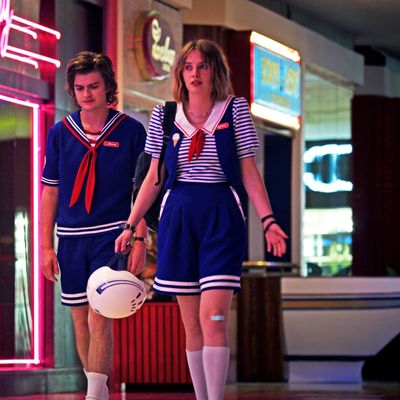
Befitting Stranger Things’ loving ode to the ’80s, the golden age of merchandising, there sure is a lot of Stranger Things crap for sale. Need a copy of Hopper’s Magnum P.I.–inspired Hawaiian shirt for your own date night? Provided you’re not actually David Harbour–size, Hot Topic has you covered. Did you flip out over Eleven’s loudly patterned jumpsuit, the one that looks like the In Living Color credits in romper form? Hope you got to Target before everyone else did. The list of licensed Stranger Things tie-ins is both long and varied in intensity, from Funko Pops to full-on cosplay. But this year, those seeking an even more immersive experience have been making a pilgrimage to the place where all this stuff was fake-bought: the Starcourt Mall, the gleaming new addition to the perpetually endangered town of Hawkins, which in our comparably drab 21st-century reality is known as the Gwinnett Place Mall in Duluth, Georgia.
However, once again, you probably should have hopped on that already: The Atlanta Journal-Constitution reports that the Starcourt set has been dismantled and discarded, largely to deter the many curiosity-seekers who have been swarming like rats to fertilizer, vying to break through the gate into Stranger Things’ uncanniest alternate dimension.
It’s easy to see what these fans are drawn to. Starcourt is easily the Netflix series’ most ambitious 1980s homage: a life-size replica of a shopping mall in its Reagan-era heyday, complete with period-accurate façades of long-gone retailers and fully stocked interiors for storefronts that weren’t even seen onscreen. It was a monumental task that, as production designer Chris Trujillo explained to the L.A. Times, was made possible only because Gwinnett Place had fallen into “a state of almost complete disrepair,” enabling the crew to take over an entire derelict wing for filming.
Prior to production, Gwinnett was infamous as the site where the body of a murdered 19-year-old woman was found inside the vacant remains of a Subway, a ghoulish illustration of just how far it had tumbled since its 1984 opening. And although it’s technically still in business, Gwinnett’s decline had left it with “a very sad, kind of abandoned feeling,” Trujillo says — “A little haunted,” star Finn Wolfhard told Jimmy Fallon — that worked in the show’s favor, making all those Starcourt scenes seem slightly, impalpably unnerving. Even forgoing the fact that Starcourt is the stomping ground for Russian baddies and oozing demons, it’s thrilling, poignant, and downright weird to see a shopping mall that’s so vibrantly alive again. You can understand why people would want to come and gawk, eager to revisit a simpler, less morbid time — even if it’s one that never actually existed.
This kind of longing for the superficially reconstructed past is Stranger Things’ least strange thing, of course. Nostalgia is one of the show’s primary creative forces, and its massive success can be at least partially attributed to the way it both soothes Gen-Xers and amuses millennials and Gen-Zers with its endless mixtape of Star Wars riffs, neon shirts, and schlocky Corey Hart ballads. The retro-scavenging of creators Matt and Ross Duffer often straddles the line between loving verisimilitude and kitschy theme party, and in that sense, the mall is just one of the show’s many winking references — a Can you believe people really lived this way? artifact that today seems as obsolete as the Ford Pinto driven by Winona Ryder’s Joyce. Like the Dragon’s Lair arcade console that so enraptured the kids in season one with its cutting-edge LaserDisc technology, there’s both comfort and comedy to seeing Starcourt’s Sam Goody storefronts and Jazzercise studios, and it doesn’t really require any further context to get it. It’s enough just to see these things and remember when, even if (or especially if) you didn’t experience it the first time around.
But the nostalgic pangs Stranger Things is provoking this time aren’t just about the silly, sentimental glimpses of Aquanetted teens strutting past resurrected Waldenbooks and long-deposed Chess Kings. As evidenced by those tourists, this season has tapped into a yearning for an age when the mall was still the center of American life, the neon-lined town square where all our lives and stories converged. It’s a setting that, it goes without saying, the Duffers borrowed as well: In addition to the usual cribbing from John Carpenter, David Cronenberg, Wes Craven, et al., Stranger Things 3 pays heavy tribute to the many movies that have exploited the mall’s vast narrative potential over the years. The most overt of those homages is to Amy Heckerling’s Fast Times at Ridgemont High — not only in its Phoebe Cates cutouts, or Steve’s demeaning little shorts, but in the way it similarly presents the mall as an air-conditioned civilization unto itself, where all the frustrated yearnings and minimum-wage humiliations of youth can play out in a hermetically sealed simulacrum of the real world. Fast Times, along with spiritual successors like Mallrats and Heckerling’s own Clueless, once treated the mall as a modern-day agora, where teens from every social stratum could gather and navel-gaze into their own petty little tragedies for a while. Stranger Things does much the same, using Starcourt as the friendly confines where the kids can sneak into movies, go on Madonna-scored makeover montages, and fumble through their first awkward romances, at least until the monsters and machine guns come out.
This juxtaposition is key to the mall’s pop-culture legacy, of course, as seen in the season’s other major reference point, Back to the Future, a movie where Libyan terrorists and disruptions of the space-time continuum clash against the suburban serenity of the Twin Pines Mall. And although the surprisingly well-curated Starcourt multiplex screens Back to the Future next to Day of the Dead, that film’s predecessor, Dawn of the Dead — where the mall becomes a temporary bulwark against hordes of zombies and rampaging bikers — proves the more obvious influence, particularly as Starcourt becomes the setting for the season’s climactic battle. Pop culture has long played off this notion of evil suddenly invading the mall’s sanitized surroundings, and while it’s unlikely the Duffers specifically had, say, Chopping Mall, or Phantom of the Mall: Eric’s Revenge, or even Paul Blart: Mall Cop in mind while concocting their own escalator standoffs, they’ve intentionally tapped into a storytelling heritage that’s cemented the mall as a place where anything can happen. You can see why modern storytellers would feel compelled to return to it, even as the mall is increasingly less a part of our story.
These days, of course, the mall is an increasingly desolate place, and our stories reflect that. It’s the symbolic dead end prowled by Seth Rogen’s dangerously deluded security guard in Observe and Report. Or, in its most striking depiction this decade, it’s the dilapidated retail wasteland of Gone Girl, a haven for assorted ne’er-do-wells who lurk beneath crumbling escalators, doling out drugs and exposition dumps to anyone foolhardy enough to wander inside. This portrayal dovetails with the growing online fascination with the “dead mall” — a sort of benignly dark tourism that’s tracked across countless Tumblrs and YouTube videos — and the proliferation of photo blogs and books dedicated to documenting the mall and its denizens in their bustling, frizzy-haired prime. As much as Stranger Things exploits those fond remembrances of the mall in its Fast Times heyday, it also draws heavily on our grim recognition of its current state, causing us to get all choked up over a Wicks N Sticks, of all things.
Change and the pain it causes is, after all, a dominant theme of Stranger Things 3. The A/V Club kids are all grappling with growing up and growing apart, the looming, upper-lip shadow of puberty encroaching on their safe basement world. Similarly, the people of Hawkins wring their hands over the decimated small businesses Starcourt has left in its wake, agonizing over the way the mall is “changing the fabric of our town.” Driving this message home, we drop by the town’s video stores, its newspaper offices, and its multiplexes — all businesses that are today every bit as endangered as the mall that once seemed so indomitable.
Maybe it’s a bit ridiculous to get sappy over a bunch of no-longer-trendy clothing stores and forsaken hot-dogs-on-sticks. But all of these sentimental feelings are, at their core, about the loss of human connection, a longing for the shared spaces and monocultural moments that have become so rare in our fragmented, isolated age (and of which the Stranger Things phenomenon is, ironically, one of the last remaining vestiges). Starcourt is a symbol of that loss, and the show taps into this sublimated grief as effectively as it does all our other misty-eyed feelings about the recent past.
While some bullish analysts may argue that the mall isn’t so much dying as evolving, or that today’s tech-exhausted teens might actually end up saving the mall in their endless search for something “real,” the fact remains that the mall’s reign as the glittering hub of national life is over, and that most of these once-thriving shopping centers are now on borrowed time. Gwinnett Place is certainly one of them: Although it enjoyed a brief boom in attendance thanks to its newfound celebrity, it’s up for sale and seemingly destined for demolition, with some proposing to turn it into a cricket stadium. Plans to turn the leftover set into a permanent Stranger Things attraction were explored but ultimately dashed, the Journal-Constitution reports, to the dismay of the county’s local tourism board, as well as anyone who had hoped to visit this living monument to history, however artificial. There’s just not much future for a place where people are far more interested in touring a fake replica of a mall than actually shopping in one, and the fascination and warm feelings surrounding Starcourt are rooted in our coming to terms with that. It’s enough to make you want to get together at the food court and throw the mall a proper wake — although your friends would probably rather stay in and watch Netflix.




